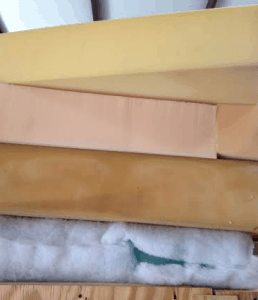Our Blog
Should Foam Be Replaced When Reupholstering A Piece of Furniture?
June 10, 2015 03:30:02pm

Nothing feels better than collapsing onto your sofa at the end of the day, or relaxing on your overstuffed armchair with a good book. Comfortable padding is most likely what draws you to your favorite piece of furniture. When fabric fades and becomes thin, you likely schedule an appointment with a good furniture upholstery service to have your furniture reupholstered, but what should you do when the foam padding wears down?
Understanding Foam & Padding
The cost of replacing your cushion and the ease with which you’ll be able to do so depend on the materials used, which in turn, depend greatly on the era in which it was manufactured.
- Contemporary Furniture – Cushioning that is manufactured today is almost always made of polyurethane or a similar polymer. A spray foam of this material is poured into large blocks or “buns.” The mixture expands and cures, and then is cut into large sheets and distributed. The small pockets of air that are formed during this process give the polyurethane foam its sponginess, and as the foam ages, the sponginess decreases. This foam is easy to replace when the time comes, and is available in varying levels of density as well as cost.
- Antique Furniture – Decades ago, foam cushioning was made using rubber rather than petroleum-based polymers like polyurethane. The manufacturing system was much the same, but with a rubber spray foam, which gave cushions significantly more spring, and resulted in a higher quality product than the polyurethane foam. Rubber foam is harder to find now, so if you want to have the rubber foam replaced in your antique furniture, it will need to be reused from another antique piece, or simply replaced with modern foam.
- Heirloom Furniture – Very old antiques, of course, are made entirely of natural product. To cushion furniture in eras past, a spring unit was made by hand, then wrapped in cotton, and padded with raw cotton or horsehair. Horsehair made excellent padding for furniture because it deterred bugs and maintained its shape for decades. Believe it or not, horsehair is still available to purchase, but more commonly, it is reused from other antiques. If you are passionate about preserving the authenticity of your antique, rest assured that the best antique furniture repair shops know how to work with horsehair to maintain your antique padding. On the other hand, if you are more interested in simply enjoying your antique, a skilled upholsterer can easily replace the horsehair cushion with contemporary foam.
How To Tell If You Need New Foam
As our master craftsman, Bill, points out, “Foam is in many types of furniture, in all types of places, and it all breaks down at some point. The key is to know when to have it replaced.” As foam ages, it goes through a process of disintegration.
- First, foam loses its elasticity. Have you noticed that your sofa, loveseat, or favorite chair is just not as comfortable as it used to be? That’s an indicator that the foam is breaking down. The foam most likely does not need to be completely replaced yet, but it may need some help. For example, a good furniture upholstery company can insert a layer of 1-2 inch foam to supplement the existing pad.
- As the disintegration process continues, foam loses its shape. Unzip one of the upholstered cushions and look at the piece of foam. Are the corners rounded? If so, replacing the cushion is a good idea.
- Next, the foam begins to break down. Once again, unzip the fabric of a cushion. Are there dry flakes coming loose from your cushion? That’s a sign that new cushions are needed. Craftsman Bill also mentions that “if the fabric wrinkles easily on the cushions, that means the foam has disintegrated and shrunk, and the fabric does not fit as well as it should.” Note that this will cause harm to the fabric itself, and if you don’t replace the foam, you may need to reupholster the fabric sooner than planned.
- In the last stage of the process, the flakes turn to a powder. Is powder puffing out of the zipper or seams of your cushions? Consider that a red flag, and schedule an appointment with a great furniture upholsterer as soon as you can!
Reupholster The Fabric, Evaluate The Foam
When the time comes to reupholster your furniture, take the time to evaluate the condition of the foam cushion. If it needs to be replaced, you have many options. You likely won’t have to consider horsehair, or even rubber, but even among synthetic foams, you can choose from many densities, levels of comfort, and cost. The best thing you can do for your furniture is find a great refinishing and upholstering shop with technicians who understand foam. At Jax Furniture Refinishing & Upholstering, for example, we specialize in foam cushion replacement and know the right density to recommend for each type of furniture. Homeowners in downtown Jacksonville, historic Riverside Avondale, Ponte Vedra Beach, Atlantic Beach, and throughout Northeast Florida call Jax Furniture Refinishing & Upholstering for the highest quality care and craftsmanship for their fine furniture.








